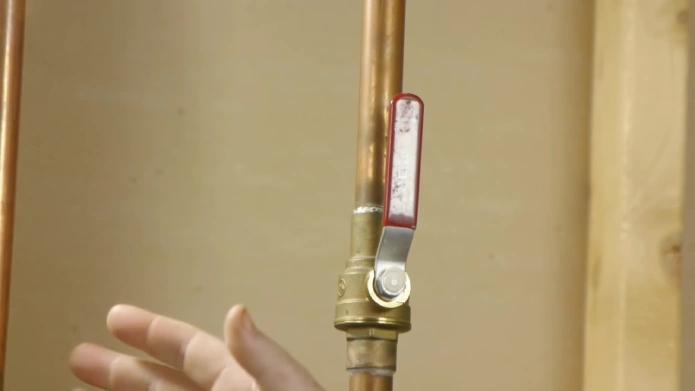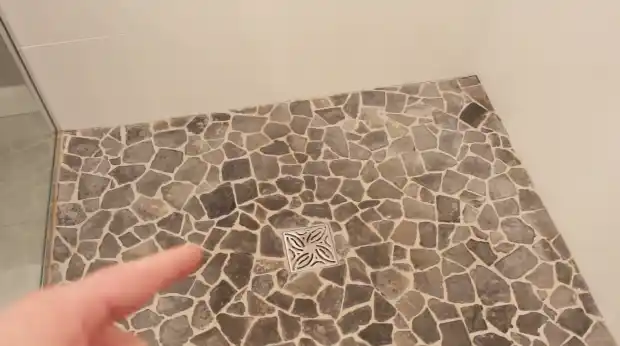Last Updated on May 18, 2023
Consistent water pressure is a must for keeping your fixtures and plumbing system running smoothly. So when you start experiencing inconsistencies, it’s essential to get to the root of the problem.
Most likely, this lies with a malfunctioning water pressure regulator, an essential device that keeps things ticking over nicely. Finding where they’re located means you can quickly address any problems before damage has time to set in.
In a residential home, the water pressure regulator is typically installed on the main water supply line right after the shut-off valve, usually near the foundation or basement of your house. Sometimes, it may even be outside, near the point of entry of the main water supply line.
In commercial properties, it’s usually near the main water line. Let’s talk about why one might be necessary and how to tell if yours is working its best. Plus, find out how easy it can be to adjust a water pressure regulator.
Where Is Water Pressure Regulator Located: Explained

Not all houses have water pressure regulators, but they can be beneficial if your house has higher-than-normal water pressures from the main line.
Generally, city or water districts won’t pump water at pressures higher than 60 psi, so a pressure regulating valve isn’t usually necessary.
In certain cases, installing a pressure-reducing valve can help keep the water pressure in your home safe.
A pressure-reducing valve is designed to maintain constant pressure throughout your pipes, regardless of varying supply pressures from the city water center.
It works by adjusting the incoming pressure depending on what’s required for your household, usually about 50 psi. This helps ensure that you’re not using too much energy due to unnecessarily high pressures and prevents damage to pipes and fixtures from too high of a flow rate.
If you live in an area where you experience high water pressure regularly, then installing a water pressure-reducing valve is recommended.
In some areas, homes located at the bottom of a steep street may also need one due to increased incoming pressures from gravity alone.
If that’s the case, it’s important to always check with local codes and regulations before installation to make sure that you comply with any relevant laws or ordinances.
How Do I Know If I Need a Water Pressure Regulator?

If you’re experiencing any of the following symptoms, it might be time to consider a water pressure regulator. Don’t delay taking care of these signs, do something about them now.
1. High Water Pressure
With water pressure exceeding a healthy balance of 80 psi, it’s time to consider investing in a helpful device.
Regulating your water pressure can be key for lowering the force and easing stress on your plumbing system and appliances, saving you from potentially costly repair bills.
The first step to determine if your pressure is too high is to measure it. You can purchase a water gauge from any local hardware store or online.
Connect the gauge directly to a faucet and turn it on until it reaches full pressure. If the reading on the gauge is consistently above 80 psi, then it’s a sign that you have high water pressure and should consider installing a regulator.
2. Water Hammering
Water hammering is a sign of high water pressure and should not be ignored. You may need a water pressure regulator if you hear banging or rattling when you turn off a faucet or valve.
This noise occurs because when the flow of water suddenly stops, there’s an abrupt change in momentum which causes the water pipe to vibrate rapidly and make noise.
If your pipes are constantly making knocking sounds even when no one is using them, this could also be caused by excess pressure in the pipes and signify that it’s time to install a water pressure relief valve.
3. Leaks
Leaks are another common problem associated with high water pressure, as they excessively strain pipes, fittings, and fixtures throughout your home.
If the pressure gets too high, there may not be enough space for the pipe joints and seals, leading them to crack or come apart altogether, causing leaks.
Leaving these leaks untreated can cause lasting damage to your home and cost a lot of money to fix. So it’s best to install a regulator as soon as possible if you notice any signs of leaking due to high water pressure.
4. Constant Repairs

If you find yourself dealing with frequent plumbing problems such as burst pipes or leaks, this might indicate elevated water pressure levels in your home.
These issues may seem minor, but over time, they can add up, leading to an increased demand for repairs or replacements of fixtures throughout your house.
Expenses could have been avoided with a quality water pressure regulator valve. By preventing unnecessary repairs and keeping your household plumbing system running smoothly, you will save time and money in the long run.
5. Shortened Lifespan of Appliances
High water pressure can also affect the efficiency and lifespan of many appliances in your home, such as washing machines and dishwashers.
When the water enters these appliances at very high pressures, it puts extra strain on their components and parts. This can cause them to wear out faster than usual, reducing their lifespan significantly.
To prevent this, consider installing a water pressure regulator in your home.
This device controls how much water enters the house so that appliances receive an adequate but not excessive amount of pressure. That way, they’ll last longer without needing repairs or replacements.
6. Expensive Water Bills
If you find yourself with ever-increasing water bills despite no significant changes in usage habits, then there’s a good chance that you have excessive water pressure in your home.
High-pressure levels require more energy and resources from the municipal supply system to deliver the same amount of flow as with lower pressures. This results in higher costs for you each month on your bill.
Setting up a water pressure regulator can help protect your finances and reduce any strain placed on local infrastructure.
How Do I Know If My Water Pressure Regulator Is Working?

Ensure that your water pressure regulator is running smoothly with these easy steps:
1. Measure the Water Pressure
To know if your water pressure regulator is working correctly, you should first measure the incoming water pressure. This can be done by using a pressure gauge.
You should check the readings both before and after the regulator and compare them to your plumbing system’s recommended maximum pressure, usually around 80 psi.
After passing through the regulator, if the reading drops to within the range, then it’s in good working order.
2. Observe Water Pressure Changes
Another way to tell whether your water pressure regulator is functioning correctly is to observe how much water pressure comes from your faucets when running.
If you notice that there are no spikes in pressure or sudden changes, then this could mean that you have a well-functioning regulator.
Whatever, if your water pressure varies wildly from one faucet to another or fluctuates over time, your regulator could be wrong.
3. Listen for Water Hammering
Water hammering occurs when there are significant fluctuations in water flow through pipes and valves. This is usually caused by valves closing or opening too quickly or too slowly.
Listen for loud banging noises coming from pipes beneath your sink or other fixtures in your house if you suspect water hammering.
If you detect such noises, this could suggest that there are issues with your current regulator, and it will likely need replacing.
4. Inspect the Regulator for Leaks
You should inspect your water pressure regulator itself for any leaks or damage, such as rust on its exterior surface.
Leaking regulators can cause major problems over time, so it’s important to check them regularly for any signs of wear and tear as soon as possible.
If you find any kind of leakage coming out of yours, then this indicates that it needs replacing as soon as possible to avoid further complications down the line.
How Do You Adjust a Water Pressure Regulator?

Adjusting a water pressure regulator is not a difficult task. The key is understanding the basics of how it works and having the right tools. First, locate the regulator’s set screw.
This will usually be on the side of the unit and may require a wrench or pliers to access it. Once you have identified it, you can begin adjusting the water pressure.
Turning the setting screw clockwise increases the pressure while turning it counterclockwise will decrease it. Turn it slowly and in small increments until you reach your desired pressure level.
How Long Do Residential Water Pressure Regulators Last?
Good-quality water pressure regulators are built to last, and that’s no exaggeration. On average, you can expect a top-of-the-line water pressure regulator to last anywhere from 10 to 15 years.
The exact lifespan of a residential water pressure regulator will depend on several factors. Longevity is determined by both the quality of the regulator and the amount of use it gets.
If mineral buildup or corrosion sets in due to high-content waters or constant exposure over long periods, then, unfortunately, longevity may be affected.
Can You Install a Water Pressure Regulator Without a Pressure-Reducing Valve?
Installing a water pressure regulator system is necessary for maintaining a safe and functional plumbing system in any building. However, it is important to note that a pressure-reducing valve (PRV) must be installed as a crucial system component.
The PRV reduces the water pressure from the main supply to a lower, safer level suitable for the building’s plumbing system. Without a PRV, the increased water pressure can cause leaks and burst pipes and potentially jeopardize the safety of the building occupants.
Therefore, a PRV in any water pressure regulator system is highly recommended.
Where Can You Find Affordable Pressure Reducing Valves?
Looking for a good deal on pressure-reducing valves? Lucky for you, online shopping has got you covered. You’ll find many options from trusted retailers and suppliers, with valves in various materials, sizes, and price points.
Before making any purchase it’s important to research and compare prices from multiple sources to ensure you get the best deal possible. In addition to browsing online retailers, you can read our helpful article on affordable water pressure reducing valves and our all-inclusive guide to PRV valves.
By taking advantage of these resources, you can gain the knowledge needed to make an informed decision that meets your specific needs and budget.
Maximize the Longevity & Safety of Your Plumbing with Water Pressure Regulator
It goes without saying that having a functioning water pressure regulator is essential for safeguarding your plumbing and you.
In most cases, it’s installed after the main shut-off valve and before the first branch line. To ensure that they are working properly, you can measure the water pressure with a gauge and inspect them for any signs of leakage or other issues.
Maintaining your water pressure regulator will keep your plumbing system reliable and safe for years.



